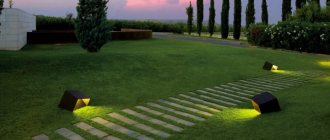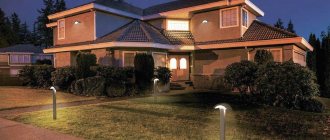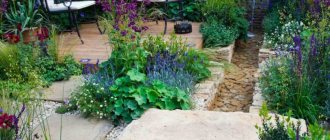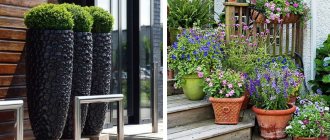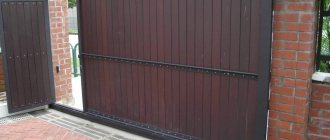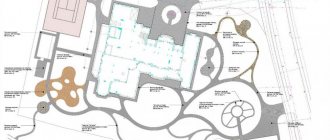No matter how luxurious and beautiful the courtyard of the house may be, garden paths with original landscape design without high-quality and technically correct lighting at night lose their aesthetics.
Garden path lighting can be organized to perform one or more functions:
- decorative;
- functional;
- architectural;
- security
The purpose of functional lighting is clear: it is used to increase the level of safety when moving along garden paths at night. Security systems are designed to create the illusion of human presence, which prevents unauthorized access to the territory of the house if the owners have gone somewhere.
The roles of decorative and architectural lighting are approximately similar: the installed systems decorate garden plots and emphasize the ideas that were implemented in landscape design.
Requirements
Before planning garden lighting, you should decide on the main functions that are assigned to it.
Unlike other types of street lighting, special requirements are imposed on path lighting:
- The luminous flux from lighting fixtures should clearly highlight the boundaries of the site and the sidewalk.
- Street lights for the garden path should be located significantly below eye level and should not dazzle people moving along it.
- Due to the location of garden lanterns directly in the open air, they are exposed to direct exposure to all atmospheric precipitation, therefore the degree of dust and moisture resistance is selected with a value from IP57 to IP68.
- Must correspond to the temperature conditions within which the street lighting device will be operated.
- The external parameters of artificial lighting should fit harmoniously into the landscape design of the garden, both in the dark and in the daytime.
- Due to the long operation of the lighting design, it is necessary to ensure that the energy consumption is as low as possible, otherwise its work will cost a lot of money.
Photo ideas
And finally, I would like to present to your attention some interesting photo ideas for creating path lighting with your own hands:
Backlight options
All landscape lighting, depending on the tasks set, can be divided into two large groups: functional and decorative. Let's take a closer look at each of them.
Functional
Functional lighting
The main task of functional lighting is to ensure sufficient visibility in a certain area of the garden plot. Classic street lights with a small leg or installed in the ground are suitable for this. Structurally, at the top of the lighting fixtures there is a flat reflector that directs the light down. Some models are equipped with diffuser-type lampshades, which create a uniform distribution of flow in the surrounding space.
Additionally, in addition to garden design, lighting of pedestrian paths can be combined with the main lighting of the area on high floor lamps. It can also combine the functions of emergency or security lighting.
Decorative
Decorative lighting
Decorative lighting is intended not so much to increase visibility within the path and landscape objects, but to create a decorative effect. Lamps for decorative lighting have a fairly wide selection of both design and color variations; there are models made in the shape of fairy-tale characters. They do not differ in significant brightness of the glow, since they highlight only the contours of surrounding objects or are themselves beacons of the existing landscape.
Types of lighting
Garden lighting can be divided into several types: technical (functional), decorative, security, and architectural.
If you decide to make your own garden lighting, you need to remember that technical lighting is done at a certain height, but not too high, so as not to disturb the comfort. An example of technical lighting is lights at the gate. The light should fall from top to bottom.
Decorative lighting should highlight the advantages of landscape design and complement it with new colors. This lighting is usually installed in recreation areas, near alpine slides, and ponds. After all, just one backlight can completely change the picture of the garden.
Security lighting serves for protection and creates the effect of the presence of people. This lighting can be divided into 2 types. In the first type, the lighting automatically turns on at night (photocells turn it on and off). In the second case, the lighting turns on at the slightest movement (motion sensors are installed here).
Architectural lighting, as a rule, not only illuminates the house, but also combines technical and decorative functions. Also see possible options for architectural lighting of houses on the website https://ekodis.com/stati/240-novogodnee-osveshchenie
Selection of light bulbs
Due to the fact that lighting a personal plot is quite an expensive pleasure, the type of light bulbs plays an important role, as it determines the efficiency of the device and other operating parameters. Efficiency refers to the amount of luminous flux produced per watt of electricity consumed.
The most common options for outdoor garden path lighting are:
- Incandescent lamps have a fairly low efficiency - about 8 - 10 Lm/W. Most of the electricity is spent on heating the coil (about 95%), and the rest is used for light emission. The advantages of such light bulbs include their low cost, but their service life is about 1000 - 2000 hours.
Incandescent lamp
- Halogen lamps work by heating the coil inside an inert gas, which promotes better light output. Their performance is about 10 - 18 Lm/W, and their service life is about 4000 hours. The advantages of halogen light bulbs include their low cost.
Halogen lamps
- Luminescent - they work due to the ionization of mercury vapor in a sealed flask, they are capable of delivering about 25 - 50 lm / W, the service life is about 5000 hours. The disadvantages of fluorescent light bulbs include their significantly higher cost and operating temperature limits. Since they may not light up when the thermometer readings are negative, they are used to illuminate paths only in the warm season or in the appropriate climate zone.
Fluorescent lamps
- Sodium lamps are also a variant of gas-discharge lamps, but ionization occurs in sodium vapor. One of the most profitable options for path lighting, as they produce about 90 - 110 Lm/W and can last about 30,000 hours. The disadvantage of such devices for lighting pedestrian areas is their cost. And color rendering parameters.
Sodium lamp
- LED lamps - produce luminous flux due to the diffusion of particles in semiconductor elements. They have the best light transmission for path lighting - about 90 - 120 Lm/W, their service life is about 50,000 hours. Unlike the above options, they are not afraid of depressurization of the flask. The disadvantages include high cost.
LED lamp
The choice of a specific model for lighting garden paths depends only on your needs. For example, in a country house where you visit only on weekends, you can easily use incandescent and halogen lamps, but in places where you use them every day, it is better to give preference to LED or sodium types.
Festive decorative lighting of the site
Many owners of country cottages often carry out non-standard decorative lighting on the eve of holidays (New Year, Easter, March 8). To create a special atmosphere, you can use the following types of lamps:
Fairy lights
They can be completely wrapped around trees or used to stylize the facade: placed above window openings, along the perimeter of the roof. For trees, garlands in the form of thin sticks with LEDs inside can also be used.
Grids with LEDs (a subtype of modern garlands)
They can be fixed in flower beds or placed on the walls of the house.
Glowing figures
They are a metal frame supplemented with LEDs. They produce a bright, soft light, allowing you to illuminate a small area around you. There are also small figures (in the form of New Year's wreaths, flowers or flat silhouettes) that can be mounted on the facade for festive lighting.
Choosing a place to install lamps
Depending on the location of the lighting of garden paths, there are three main positions: on the path itself, on the side of the road, on decorative elements of the garden. Each of them has its own criteria for choosing equipment and its parameters. Let's look at each of them in more detail.
On the track
On the path
If the installation of lanterns is planned directly within the path, they are made of small sizes. Size is especially important for recessed lighting fixtures, which are arranged like LED tiles or LED strips.
Such models must have increased strength, since they will absorb the full load from pedestrian traffic. At the same time, they are of a decorative type, so they do not require high brightness and directional flow of light, otherwise the lighting will blind those passing along the path and the surrounding space will seem even darker.
On the side of the road
Near the path on the side of the road
If the path is already lined with finishing material and there is no desire to violate its integrity, it is much more profitable to use the free space along the path.
Installation of lamps for this place requires some elevation of the lampshade above the illuminated surface, so any floor lamp, pin or ground-based models are suitable here. An important criterion when choosing them is a sufficient level of illumination in functional areas.
On decorative elements
Illumination of trees
If the garden decor is already rich in a variety of all kinds of details and decorations, you can also use them to illuminate the paths. Such elements can act both as a supporting structure for the lamp and as a lighting device itself.
A popular direction is the installation of indirects - devices that direct the light flux to any object, from which it will subsequently be reflected into the surrounding space. A striking example is the lighting of garden sculptures installed near the path, illumination of facades, illumination of plants and trees. An important criterion is that all these elements must be located in close proximity to the sidewalk so that the light effects on them reach the ground surface.
Examples of using
With a large number of luminous stones, you can completely abandon traditional methods of street lighting. Magic pebbles can be used to decorate the borders of paths, thereby shaping their outline, illuminating the direction and marking the boundaries of the pedestrian zone.
Idea: small glowing stones (crumbs) can be used in the process of laying garden paths - simply add glowing stones to the concrete, thereby creating the effect of a starry sky.
Glowing path of crumbs
Also on our website: lighting of a summer cottage.
In addition to being used for paths, luminous pebbles can be used to decorate flower beds and flower beds, or lay them out on the lawn or near large trees. Such lighting will look very harmonious near pools and ponds, as well as near recreation areas.
Plant lighting
It’s very easy to make glow-in-the-dark paths in your dacha with your own hands. Options for decorating a site using luminous elements are limited only by your imagination. With the help of such original crafts, the territory of the house will be filled with a magical atmosphere and bright colors!
From this video you will learn how to make a phosphor with your own hands.
Circuit examples
Before starting installation work, it is important to arrange proper lighting on the site, taking into account the main and secondary paths. First, you will need a site plan with markings of the main landscape elements and buildings. The plan marks the installation points of the lamps and the radius of illumination or the coverage area of the luminous flux. An example of such a plan is shown in the figure below:
Examples of path lighting schemes
When choosing the power and coverage radius of a specific lamp, keep in mind that the functional lighting of the main paths differs from the illumination of additional paths.
For example, the central alley of the garden should be illuminated by more powerful devices; lighting fixtures should be installed in larger quantities. Side paths and driveways do not need to provide as much visibility, so less powerful units are suitable.
Also, when designing a scheme, you need to take into account the flow from floodlights aimed at the paths, architectural lighting and lighting of artificial reservoirs. In these locations, additional lighting may be unnecessary, since the light from these lamps will be more than enough. And together they can significantly worsen the decorative effect and lead to unnecessary energy consumption.
Combined lighting scheme
As you can see in the figure, the lighting of the main path is indicated by yellow circles; in places where the lamps of the pond, flower beds and facade block the pedestrian part, they do not need to be installed.
Video example of the work result
The appearance of the lamps should be in harmony with the design of the surrounding space. The abundance of decorative elements and light play, combined with numerous delights, will overload the visual perception and create an irritating feeling of chaos. In this case, it is better to use simple or hidden light sources. But a strict landscape can be diversified with stylish lamps of unusual shapes.
- Author: Shandi
Rate this article:
- 5
- 4
- 3
- 2
- 1
(2 votes, average: 3 out of 5)
Share with your friends!
Installation process step by step
If you are just making a sidewalk or finishing a finished base, you can install lamps directly into the path itself. For this:
- Prepare holes according to the dimensions of the lighting fixture - it is more convenient to do this at the laying stage in order to pour a rigid form into the concrete.
Prepare a hole for the lamp
- Draw a power supply line to each of the lamps - it is also more convenient to install the cable filling at the stage of pouring the base.
Route the cable to the lamp
- Prepare an adhesive solution for natural stone - in this example, the path will be finished with stone, so it is important that the adhesive base is designed for the minimum and maximum temperatures in your region.
Prepare a glue solution
- Connect the lamps and install them in the appropriate niches.
Place lamps in niches
- Glue stone tiles around the light fixtures.
Glue the stone tiles
If the path is already installed and no modernization is expected for it, lighting fixtures can be installed on the side of the road next to it. To do this you will need:
- Dig holes where the posts will be installed and connect them with a cable trench.
Connect with a trench
- Pass the cable through the protective sheath and lay it in the trench (in our example, the watering hose plays the role of protection; it perfectly protects from moisture).
Lay the cable in the ground
- Install the posts, since in our case they consist of pipes and bricks, they also need to be laid out.
Install the posts
- Cement the supply line in the ground, this will create additional protection from both moisture and mechanical damage.
Cement the cable
- Install the lampshade and screw in the light bulb.
Install the lampshade and screw in the light bulb.
The lighting for the garden path is ready; in our example, an RGB LED lamp is used. Due to this, you can provide festive lighting from a remote control.
Festive lighting
how to design the borders of a garden path
Here we will talk not about how to maintain its shape, but about the decorative side - how to make the path even more attractive and/or original.
Stone fence.
A border of several rows of stones will be an excellent frame for the path. On the other side there may be flower beds. Thanks to such a fence, plants will not cover the path, while the stone will become an excellent backdrop for greenery. The photo shows one path from different angles.
Shady alley.
On hot days, it’s nice not only to sit in a shady corner, but also to stroll under the canopy of climbing plants that weave along the garden path. Install the necessary structures (arches, trellises, etc.) and then plant wild grapes or something similar.
You can arrange beautiful arches with roses or clematis on several sections of the path. Another 45 photos of beautiful ideas for garden arches are in our special issue.
Like in the park.
If you have a large garden or a long plot, plant trees on both sides of the path (thin trunk + lush crown). Supplement them with low-growing bushes or herbs - and your garden will always be beautiful.
Bottom lighting.
This version of garden lighting is convenient due to its efficiency and a certain “intimacy” of a walk, when the path is well lit, but walkers do not become the object of attention of neighbors.
Take a look at one of our thematic issues to see more ideas about garden lighting, including garden paths (60 photos in total).
We are completing our review of original ideas on how to make paths in the garden and country house. Choose materials that suit your site and budget, combine different techniques, and make gardening even more enjoyable!
Tips and tricks
When choosing and operating garden path lighting devices, pay attention to the following tips:
- Do not use cheap equipment options - their low quality will force you to quickly look for a replacement;
- To save money, use solar-powered models, although in the second half of the night the light will dim significantly and they will only be enough for marking lighting;
- If you use lamps for both functional lighting of paths and for decoration, select them in the same style;
- Place all communications for powering light bulbs underground so that they do not interfere with the design;
- If you want to create economical lighting for garden paths, use a motion sensor and a photo relay - the first will turn on the lighting only for passers-by, and the second only in the dark.
We design flower beds
Let's continue to talk about ideas for a garden and dacha with your own hands using the example of decorating flower beds. We will talk about borders for beds and containers in which you can plant plants. Beautiful flower beds can often be made from what you have on hand.
Tires
You can simply paint car tires, pour soil into them and plant flowers there. It is advisable that they are not tall or very decorative. The tire is not the most elegant item, so the same roses will look out of place in it. And they have a large root system. If you don't like the painting option, wrap the tire with jute rope. To keep it on the surface, you will need a glue gun. Here's what it might look like.
Instagram @countrifiedcasa
Instagram @alittle_vintagelove
The tire will also make a nice mini-pond. Its arrangement will take a little longer. A waterproof material is placed at the bottom, and the tire itself is hidden behind large stones or other material that will create the impression of a decorated reservoir.
Stones, bricks
The cobblestones can be painted in different colors or left as is.
Instagram @alphalawn92
Instagram @gulinsad
Instagram @viktoria.miroslava
Bottles
Glass, green or dark brown bottles look more beautiful. They are buried around the flower bed, bottom up, leaving half the container on the surface.
Instagram @vtarhanovke
Instagram @anastasia_gorovenko7
Old furniture, boats and dishes
Chairs, tables with drawers, chests of drawers, large teapots, dishes - all this is suitable for growing flowers.
Instagram @essa70_
Instagram @shantitatiana
Stumps, logs
After a suitable hole has been cut in the tree, it must be treated with antiseptics. Gravel is placed at the bottom, under the soil.
Instagram @super_aiymdar
Instagram @provanc_dv
Willow, cutting boards
At a dacha in a rustic, romantic style, front gardens with fences made of willow twigs or small boards dug into the ground look beautiful. If the hedge is tall, you can hang bunches of herbs or clay pots on it.
Instagram @valentina.petrenchuk
Instagram @birinacom
Decorative colored chips
This is a purchased material for mulching the soil in flower beds. It not only looks beautiful, but also helps retain moisture in the soil on hot days and preserve plants in winter. Street lamps can be placed on such beds to illuminate the flower arrangement in the evening. Instead of wood chips, shells and colored pebbles are used.
The flower beds themselves can be made multi-level, spiral, rocky. If there is a pond on the site, try making a floating flower bed. To do this you will need several things.
- Wooden box.
- Styrofoam or plastic bottles to create a float around plant containers.
- Geotextiles.
- Mesh seal.
- Priming.
- Expanded clay.
- Ground cover, moisture-loving, low-growing plants.
You can immediately cut out a shape from polystyrene foam and paint it with acrylic paint. A visual example of creating a floating island in the video.
Functionality versus aesthetics
At the dacha, the main role of lighting is to provide maximum illumination of all necessary locations on the site. At the same time, they try to optimally squeeze the functional side into an aesthetic framework. Functional lighting is a good option for those for whom the main purpose of lighting is safe movement and the ability to access any part of the site, even at night. Garden lanterns, outdoor floor lamps and ballards are ideal for these purposes.
The main task of decorative lighting is to create a unique lighting complex that will naturally fit into and complement the landscape design. Decorative lighting fixtures serve as decoration and addition to paths. This could be: decorative lanterns and figurines, stones and ribbons, lighting of bushes and trees, etc.
Creating a cozy corner for relaxation
Today we will look at some interesting ideas on how to make your garden plot even more attractive and original.
Table and chairs made of hemp
To implement the idea, you will need to stock up on wooden sections from strong wood (oak, ash, walnut) and the proper set of tools.
Each workpiece must be trimmed with a plane, the top surface must be sanded, and coated with primer and varnish in several layers. The right approach to creating a garden table will ensure long service life of the products in the country.
Table and chairs made of hewn boulders
Stone chairs in the garden are used in several styles of landscape design, but any summer resident can create such a rocky interior on his own.
Prepare a flat area, clear the ground of possible roots and metal debris. Place the main boulder table in the center of the prepared area. You will have to work a little on sanding the tabletop. Place chairs made of stones around.
